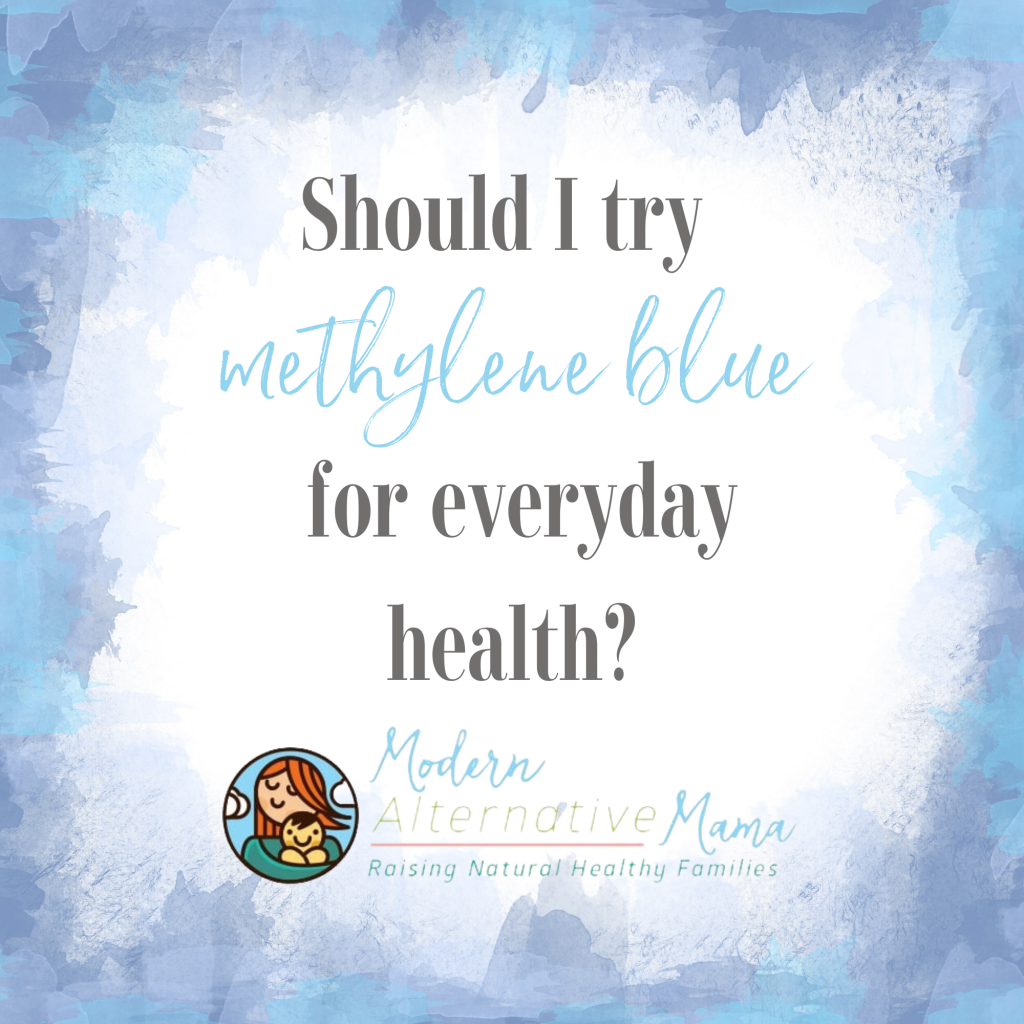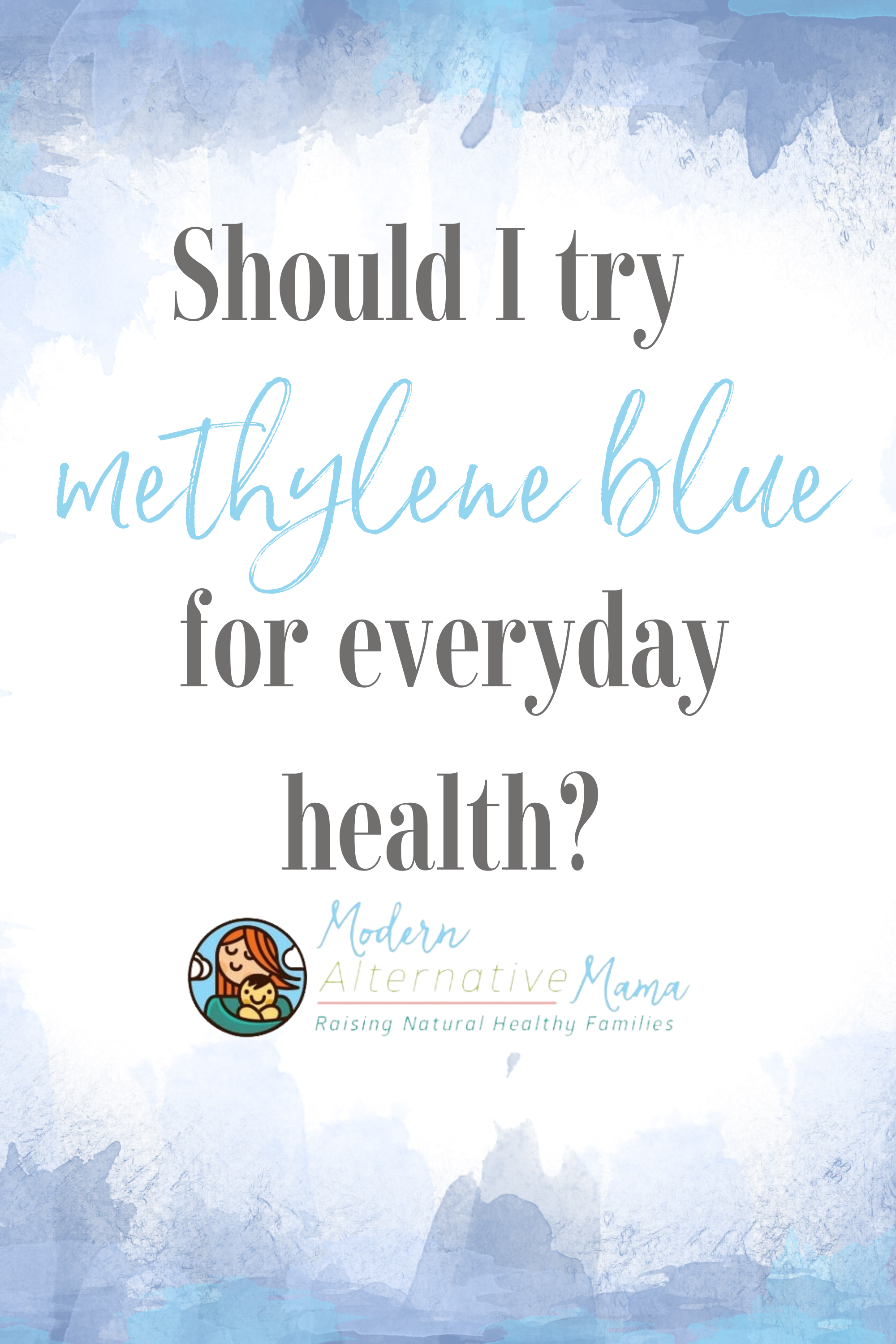By Lindsey Bussie, contributing writer
Have you heard of the latest health trend that leaves people’s tongues blue? If not, this may sound totally bizarre. If so, then you know I’m talking about methylene blue. All the social media platforms are lighting up with people sporting blue tongues from ingesting this blue dye. They’re using keywords like: energy, nootropic, brain health, biohacking, mood support, treat Alzheimer’s, mitochondrial health, and more to say how it is a one-stop cure-all.
As someone who’s been learning about natural health for the last 13 years, they caught my attention. So what is methylene blue, and should you take it for everyday health?
What is Methylene Blue?
Methylene blue started out as a textile dye in the 1800s. It was the first blue dye that didn’t wash off fiber(S). It was also used to dye cells under a microscope, and during this application, it was discovered to be a treatment for malaria (S). From here, the medical community started to study methylene blue. It was the first synthetic drug used in medicine (S).
Methylene blue was created in a lab and does not occur in nature. Methylene blue kills bacteria and viruses through its ability to make the body produce hydrogen peroxide. It does this by creating a chemical reaction within the body, rewiring the respiratory chain to output hydrogen peroxide and changing how the body uses oxygen.
The chemical reaction itself requires the use of over 300 genes and 60 proteins to make happen. The extra output of hydrogen peroxide that the body produces forces our cells to create more glutathione (a major antioxidant). So far, this sounds pretty great, right? Antimicrobial, treats malaria, and our body produces more antioxidants because it all sounds like good things.
On the surface, it may seem that way, but the truth is, methylene is very costly to the body. This means it requires a lot from our body to use. On the front end, our cells need the proper tools (vitamins, minerals, enzymes, etc.) to support these multiple chemical reactions. On the back end, our body needs to be able to clear out the extra hydrogen peroxide by breaking it down to water and oxygen again. Both of these processes use a lot of important nutrients and enzymes, and depending on your body, may cause more harm than help. So that begs the question, should I take methylene blue?
Should I take Methylene Blue for everyday health?
This methylene blue health trend has a lot of people thinking this is an everyday kind of thing, and it’s not. The biochemical cost of using methylene blue can be high, it needs enzymes like NQO1, MAO-A, cofactors like B2, B3, vitamin C, iron, and copper.
Keep in mind, these enzymes, vitamins and minerals are already being used in many other processes in the body. Taking methylene blue is an additional toll to daily function. So if you’re low or deficient in these, it can cause problems.
Another thing worth mentioning is the rewiring of the respiratory chain. This is a pathway that our bodies have to create energy and utilize oxygen. Think of it like a well-established highway. Everyone knows this is the best way to get from point A to point B. When you take Methylene blue, it tells all those cars to just drive anywhere, no roads or highways required.
In the case of a major highway blockage, this might be ok. This is why some may feel better at first when they take it. The clearing of the blockage on the highway felt better than damage that happened when all the cars drove all over the place. In the end though, you should try and find a different road map to use to clear the clog.
The chemical reaction it causes bypasses a biological process that was fine-tuned for humans throughout our history. The risks of taking methylene blue include:
- Headaches
- Dizziness
- Gastrointestinal upset
- Insulin resistance due to excessive hydrogen peroxide (S)
- Serotonin syndrome (S)
There are so many natural ways for us to get the effects that this health trend promises (I talk more about this in a few paragraphs below). Will they happen overnight? No. But they also won’t risk making you feel worse or causing complex damage that may require medical attention.
Is there a time I should take Methylene Blue?
Sigh. This is where things get sticky. I am not a medical professional, and you are getting my personal opinion based on the research I have done. I strongly encourage you to always do your own research and form your own opinion based on what you have learned.
If you have a very specific, serious health condition that hasn’t been resolved through nutrition and the guidance of a practitioner who is confident in the natural health world (naturopathic doctor, functional medicine doctor, homeopathy practitioner, to name a few), then maybe find a practitioner and research together whether it might be a good option for you. There are a lot of moving pieces that would need to be monitored and tested thoroughly before, during, and after taking methylene blue. This medical professional needs to understand exactly how methylene blue works to know if it’s a possible treatment for you.
A lot of the data and studies around methylene are animals or flawed human studies. That doesn’t mean that we shouldn’t use them (because they do still offer a picture of what it can and cannot do), but it does mean that we should proceed with caution in regard to them and that there should be more studies if we want to use it in the application of serious health conditions. If you want to know more, check out Chris Masterjohn’s paper titled “Methylene Blue: Biohacker’s Delight? Or Playing With Fire?”
But methylene blue had so many promises! What should I do instead?
I hear you. I too, saw the promises of methylene blue and thought, well, that would be really nice to be able to have more energy and think more clearly. Or maybe you have anxiety and thought, I really don’t want to try prescription medications, so maybe this is a good route to go. I’m sorry it didn’t end up being that.
But there are things you can do to take charge of your health. If you’re feeling chronically tired, check your sleep. If you’re curious about what you need to know about sleep, you can check out this sleep guide. One of my favorite go-to’s for stamina and energy is adrenal cocktails. This nutrient-balanced drink gives your adrenals the nourishment they need.
Thyroid health is another thing to look into, and if you know your thyroid is struggling, you can check out Earthley’s thyroid tincture. If you have problems with anxiety, you can try introducing magnesium into your life. You can eat more pumpkin seeds, beans, and dark leafy greens. Our skin is also great at absorbing magnesium, and you do Epsom salt foot soaks or use magnesium lotion. There is also this in-depth guide about stress and anxiety you can read.
Instead of taking methylene blue, there are ways that we can fuel our body for optimal glutathione production. The body needs several nutrients and cofactors for the production of glutathione. These include:
- Cysteine: one of the three amino acids that make up glutathione. The body can synthesize cysteine, but it can also be obtained from dietary sources like eggs, dairy, poultry, and some plant-based foods.
- Glutamate and Glycine: two amino acids required to form glutathione. These amino acids are obtained from protein-containing foods like bone broth, cheese, chicken skin, and legumes.
- Sulfur: an essential component of cysteine, and it’s crucial for glutathione synthesis. Foods rich in sulfur include garlic, onions, leeks, shallots, and cruciferous vegetables like broccoli and brussels sprouts.
- Vitamins: vitamin C (lemons, peppers, kiwi, acerola cherry powder, dandelion leaves) and vitamin E (sunflower seeds, almonds, salmon), play roles in recycling and maintaining the activity of glutathione.
- Minerals: Selenium is an important mineral that acts as a cofactor for enzymes involved in glutathione metabolism. Selenium-rich foods include Brazil nuts and seafood.
- Antioxidant-Rich Foods: Consuming a diet rich in antioxidants, including fruits and vegetables (watermelon, grapefruit, lemons, pumpkin,liver, blueberries for example) can help protect and maintain glutathione levels by reducing oxidative stress and supporting overall cellular health.
When we exercise, our body naturally produces hydrogen peroxide (S). This is at a much lower level than methylene blue, and it is a natural process therefore allowing our body to clear it more efficiently.
As far as Alzheimer’s, there is still a lot of research that needs to be done, but here are a few natural, safe ways to protect the brain:
Real, sustainable changes won’t always happen overnight, but if you’re focusing on health and nutrition, it will happen.
Is methylene blue something you’d be willing to try?







